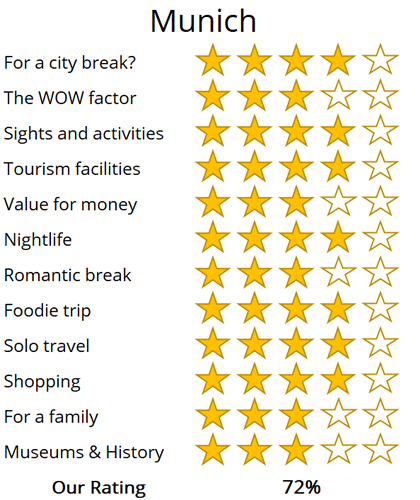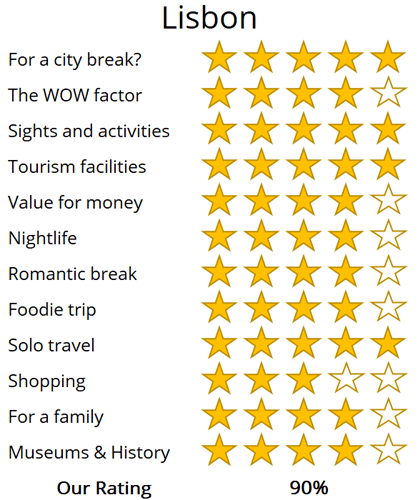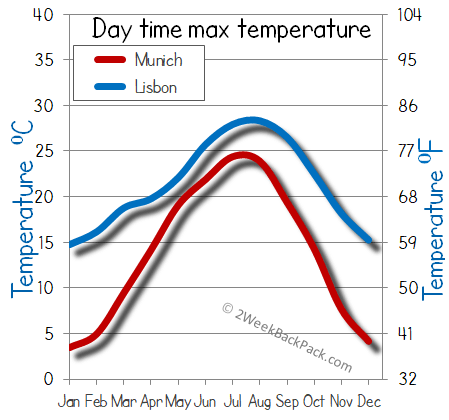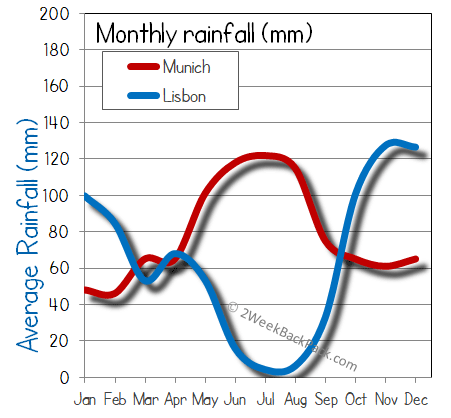WhereToGoForMyHoliday.com
The best destination comparison site!
WhereToGoForMyHoliday.com
The best destination comparison site!
Munich or Lisbon, which is better for your holiday in 2024?
Munich and Lisbon both offer unique and enticing experiences, but which one should you choose for your city break or holiday?
We recognise the difficulty in making this decision. While there is abundant information available on both destinations, clear guidance on which city better aligns with your travel preferences is often hard to find.
This article aims to provide an impartial comparison of Lisbon and Munich, and hopefully help you to choose the best city to visit.
The article is structured into several sections, each of which can be directly accessed through the following links:
• Introduction to the cities
• Scores and ratings
• Which one should I, friends, or family visit?
• When to visit and weather
• Who is the city suited for?
• The perfect 48hours (with map)
• Tourism details (where to stay? airport details?)
Introduction to Munich and Lisbon
Beer-mad and shrouded by the mountains, Munich is the boisterous capital of Bavaria. It's in the deep southern reaches of the country, where lederhosen are the threads of choice and white sausage is served at breakfast. Proudly unique, romantic, and steeped in art and culture, you won't find anywhere else like this in Germany.
Of course, it's the legendary Oktoberfest that puts Munich on the map. One of the world's biggest festivals, it draws millions to the city in late September (yes, Oktoberfest is confusingly held in September) to glug huge beers and eat endless wurst.
Trips at any other time of the year are sure to be a little more refined. They can involve long walks under Baroque churches, picnics in the English Garden park, and even daytrips to the stunning Bavarian Alps.

Munich is a vibrant city, ideal for a short trip
Lisbon is a progressive and liberal city, which still retains its rich seafaring history and distinctive Portuguese heritage. The city effortlessly blends history, vibrant culture and exciting nightlife into one charismatic tourist destination.
Lisbon is a city of compact variety; you can get lost in the maze of narrow streets in the Alfama district, be wowed by the grandeur of the plazas in Baixa or join the hipsters and fashionistas in the Principe Real. Close to the city are glorious sandy beaches, and Lisbon boasts one of the finest climates in Europe. This is an amazing city, which you must visit.
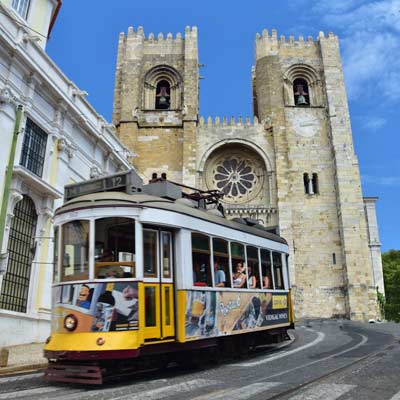
The number 28 tram passing the Se cathedral in Lisbon

The Marienplatz and the historic centre of Munich, with the Frauenkirche Cathedral, and Neues Rathaus
High-level summary for Munich and Lisbon
Summary
Where would I journey for a personal escape?
Lisbon
Where would I send my parents for a memorable visit?
Lisbon
Where's the ideal destination for my adventurous 19-year-old cousin?
Lisbon
Where should my food-obsessed friend indulge their culinary passions?
Lisbon
Note: The above comparisons are weather-independent and are based on travel during the most opportune times of the year. Details about the ideal travel seasons are elaborated upon later in this article.
In the sections that follow, you'll find a comprehensive comparison between these two fascinating cities. This includes recommendations on the duration of stay, the best times to visit, and tailored 48-hour itineraries for each city.
The final segment delves into practicalities for your travels, such as the best airport to fly into, the optimal districts for your accommodation, and insider tips, for when you come to explore the city.
We hope that you find all of this information useful, in planning your next exciting trip!
Destination details
How long to spend each city?
Lisbon is a diverse and exciting city that you’ll need at least three days to fully see.
Many visitors also include Sintra as part of their stay, but at a minimum, but we recommend spending at least two full days in Lisbon itself.
If you are fortunate enough to have a longer stay, there are many enjoyable day trips, including the palaces of Sintra, the beach resorts of Cascais or the historic towns of Obidos and Evora.
In the summer, you could also visit the beautiful beaches along the Cascais or Costa Caparica coastlines. Best of all, these day trips can all be reached via the inexpensive public transportation.
Related articles: 3 days in Lisbon – 48 hours in Lisbon
Take a couple of days minimum to get a feel for the alternative vibes of Munich. You'll need at least a morning or two to check off the grand churches and plazas of the downtown. Afternoons are often lost to a haze of currywurst and spätzle. The evenings will disappear to clinking tankards and too much Bavarian beer.
If you're planning on joining the Oktoberfest party, then the normal amount of time to spend in the Munich event is two days. Some people will stick around longer but remember that accommodation can cost a bomb during festival dates and you'll need to book well in advance.
The closeness of the Alps and the wide variety of off-the-beaten-path neighborhoods in Munich mean that it's also possible to stay here for much longer than just a weekend or a couple of days. You could do weeks of hiking in the spring and summer months. Alternatively, you could do a full ski holiday in nearby Garmisch-Partenkirchen (Germany's biggest resort) during the winter.
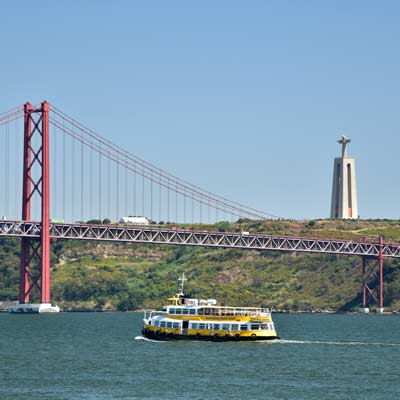
A tourist cruise boat passing beneath the Ponte 25 de Abril suspension bridge in Lisbon

Excessive amounts of beer, lederhosen, singing and crazy fairground rides… it can only be Oktoberfest
Munich is one of those cities that has something going for it no matter the time of the year. Lots of people like the height of the summer, for the regular sun and temperatures that often spike above 30 degrees in the middle of the day. That's certainly perfect for wandering the town and enjoying the big lawns and paths of English Garden.
The autumn is best known for Oktoberfest. The shindig and the beer drinking begin in mid-September, lasting until the first couple of days in October. It's usually still warm for the party, but the days get shorter and jumpers will be needed as you get closer to November.
There's often snow in Munich from December onwards. This is the time of year to come if you have your sights set on the ski fields of the German Alps. The slopes of Garmisch-Partenkirchen typically open for business before Christmas, which is also when the enchanting markets start selling gingerbread and sausages on Munich's medieval squares.
Spring is also lovely. May is among the best months of all to travel. The summer crowds haven't arrived yet, the snows have melted, and thermometers can read a pleasant 20 degrees during the day.
The recommended time to visit Lisbon is in the late spring and early autumn, when the city is sunny and warm, but without the summertime crowds.
Lisbon is subject to the pressures of over-tourism at times, most notably being incredibly crowded during the summer months in the popular tourist areas, such as the Belem district and Sintra.
Due to the increased popularity of Lisbon, it is becoming a year-round destination, however, be warned that the winter months can be wet and cool.
Our favourite time of year to visit Lisbon is during the first two weeks of June, when the whole city celebrates the Santos Populares festivals with street parties and traditional dances.
Lisbon has a wide appeal; there are cultural sights, a buzzing nightlife and a blossoming artisan scene. The city will appeal to young or old, either for a cultural trip or as a fun weekend away.
In the summer (May-Sep) the beaches make for a really good extension to your trip and are easily accessible from the city. There is little to fault Lisbon and most visitors leave with fond memories of the city.
Munich is unique in that it manages to fuse together the great outdoors, rich European culture, and an enticing foodie scene. That's all thanks to its place as the historic capital of Bavaria, which brings a long tradition of cooking, beer making, castle building – the list goes on.
The upshot? There are all sorts of travellers who are catered to, no matter if you come in search of pretzel eating or high-altitude trekking.
One thing you won't find in this city is the sea. The nearest saltwater is a hefty drive over the Alps in Italy or Croatia. So, don't come if you're pining to top up the tan and swim in the Med.

The Englischer Garten (English Garden) is the spawning park in the centre of the Munich
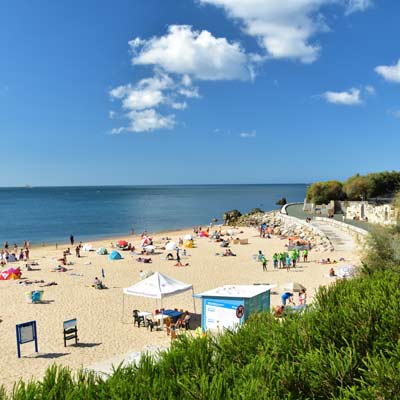
There are beautiful beaches only a short train ride away from the centre of Lisbon
There’s a lot to squeeze in for 48 hours in Lisbon.
Below is an interactive map for what we recommend doing in a 48 hour tripto the city; day 1is highlighted in green and day 2 in yellow, with optional sights in grey.
Most tours begin in the Baixa district with its grand avenues and magnificent plazas, such as the Praça do Comércio and Rossio. In the later part of the day, start to climb the hills into the Alfama district which is a maze of medieval streets leading up to the castle. Take in one of the viewpoints close to the castle for a romantic sunset and then ride the quaint number 28 tram as it rattles through the city.
For dinner, head into the Baixa district and then for a night out, head to Bairro Alto, with its funky bars and social scene which fills the streets.
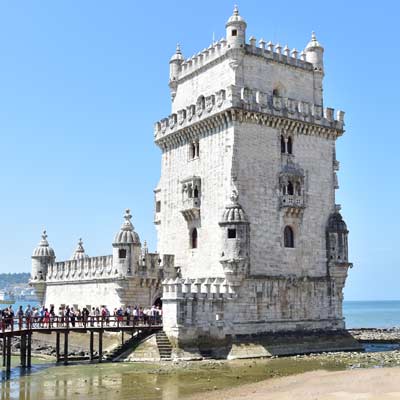
The Torre de Belém once guarded the Tejo Estuary and Lisbon
For the second day, head to the scenic Belem district, which contains the Mosteiro dos Jerónimos, and Torre de Belém, along with views across the Tejo Estuary.
For the second part of the day discover the stylish Príncipe Real and Avenida da Liberdade districts or visit the ultra-modern side of Lisbon, the Parque das Nações.
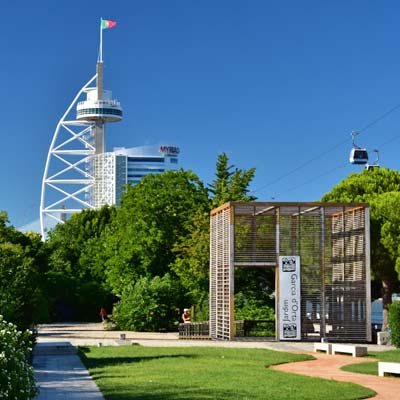
The Parque das Nações is the modern side to historic Lisbon

The Torre de Belém once guarded the Tejo Estuary and Lisbon
48hours in Munich
Sample Munich's famous food, beer, and regal inner city on this two-day itinerary that's packed with amazing palaces and parks. If you're hanging around for longer, then you should also have time to make a beeline for the Alps or explore those off-the-beaten-track neighborhoods, but that will have to wait…
Day 1: Your travels begin on the grand Odeonsplatz. A prime example of the city's 19th-century rebuilding, it hosts some of the most magnificent sights in the region. There's the huge, 130-room Munich Residenz, the onetime home of the Bavarian kings and queens. There's the Theatine Church from the 1600s, sporting its dual Baroque towers.
You only have 48 hours, but the palaces can be visited if you have extra time. Instead, move on through the heart of the city on Briennerstraße to the vast plaza of Königsplatz. This is a photo op extraordinaire, with handsome Neo-Classical monuments like the strange Propyläen. The area around that is the artistic quarter (the Kunstareal), where there are endless museums and galleries to go into if you need to warm up or escape the rain.
Next is the beautiful Frauenkirche. This is a symbol of Munich as a whole; a great church topped by bulbous domes on the central Frauenplatz. It will take around 20 minutes to walk over there, but you'll enjoy moving into the Altstadt area as you go. You should plan to spend the evening within, hopping between sights like the iconic Hofbräuhaus (the best known beer hall in the city) and the ancient Peterskirche (the oldest church in Munich).

The Schloss Nymphenburg and its beautiful grounds
Day 2: No visit to the grand royal capital of Bavaria could possibly be complete without at least a glimpse of the Schloss Nymphenburg. It's hardly central, but private tours can whisk you there and back in a single morning, going through the manicured gardens, the court rooms, and the curious Marstallmuseum with its gold-leafed carriages from the 19th century.
When you return back to the middle of Munich head straight for the English Garden. This is one of Germany's favourite parks. You could start by strolling up the Eisbach to see the surfers riding the river wave. Then explore the pretty Hofgarten, where babbling fountains and bandstands once provided a retreat for Bavarian royals. Alternatively, go straight to the Chinese Tower Beer Garden, to glug traditional German hops brews and taste bratwurst and pretzels until sundown.

The Olympiapark complex, constructed fro the 1972 Olympics
Lisbon is well set up for a holiday and is a great destination for a weekend break. The city has a lot to offer; it is safe and is comparatively inexpensive, especially when compared to other major European cities.
Lisbon is serviced by one airport, which is only 7 km from the city centre, and is connected to the metro network (€1.60 single). There are many flights to Lisbon, but there can be high demand in the summer along with the obligatory increase of prices.
For accommodation, there are the well-defined popular areas of the Alfama, Baixa and Chiado districts, with a range of hotels and rental rooms. There is a diminishing supply of low budget options, even for rental rooms, as demand is always high.
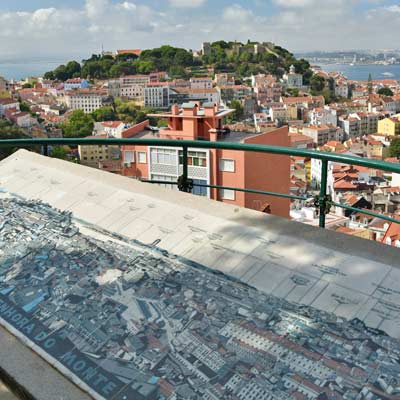
Lisbon is spread across 7 hills, which means there are many great viewpoints, and lots of hills to climb!
When exploring the city, all of the main tourist areas are centrally located and can be reached on foot,he only exception is the Belem district, to the west. There are a lot of steep hills in Lisbon, and sightseeing can be very draining in the intense summer sun.
Munich International Airport is the second busiest hub in all of Germany. It's a major arrival point, with links coming in on premium and low-cost fliers from right around the globe. Getting to the city from the terminals is easy thanks to the direct S-Bahn line that runs straight to the train station. The trip costs just over €11 and takes around 40 minutes in total.
Long-distance overnight trains and local German trains alike will arrive at Munich Central Station. It's right in the heart of the city, within walking distance of the Altstadt and the Odeonsplatz. If you'd prefer not to walk to the door of your hotel, however, you can enter the S-Bahn or U-Bahn networks from there. Those, along with the comprehensive bus routes and tram lines, can get you virtually anywhere in the town. Basic one-way single tickets cost €2.80 per ride. Buy them at the blue vending machines located in the stations.

The Odeonsplatz plaza and the distinctive yellow Theatine Church
Munich is a safe, modern city. The locals are famed for their friendliness and welcoming attitude – a trait of Bavaria, they say. However, it's still important to be wary of scams and dangers, particularly during the Oktoberfest, when alcohol intake increases dramatically.
The best areas to stay in Munich are the Altstadt, the streets around English Garden, and the grand university and gallery area of Maxvorstadt. Cheaper hotels that are still within walking distance of the sights can be found south of the main train station around Bayerstraße.
